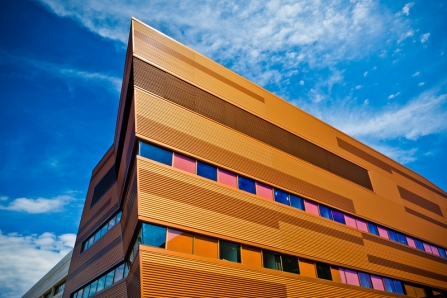The new home of the School of Engineering and Applied Sciences, designed by Perkins+Will, opened at the University at Buffalo. Co-locating the departments of computer science and electrical engineering in a single facility, the 133,000-sf Barbara and Jack Davis Hall creates an collaborative education and research environment.
Clad in glass and copper-colored panels, the three-story building thrusts outward from the core of the campus to establish a new identity for the School of Engineering and Applied Sciences and the campus at large. Formerly scattered among seven different locations, the engineering campus is now focused and consolidated, with a defined “front door” for the school and a new quad and interior common spaces.??
Davis Hall will enable the University at Buffalo to expand research in nanotechnology, pattern recognition and bio-based security systems, among other fields. The hybrid design of the hall stresses the value of interactive space for learning and discovery. The building is organized around a glass-enclosed, multi-story gallery that facilitates pedestrian traffic into the existing campus, creates an interactive educational/research environment, and culminates in a multi-tiered student lounge that activates a new courtyard shared with the existing Marcel Breuer buildings.
Facing south, the glass gallery is a daylight-filled science commons that includes open staircases that allow for spontaneous student and staff interaction. It also comprises a series of interlocking volumes that include windows into laboratories for the active display of technological research. Throughout the building, which also houses the Center of Excellence in Document Analysis and Recognition (CEDAR) and the Center for Unified Biometrics and Sensors (CUBS), cross-disciplinary zones are distributed for informal gathering spaces equipped with SMART Boards.
The new hall is tracking for USGBC LEED Gold certification through features like enhanced building shell insulation, high-performance windows and energy efficient lighting, the building improves overall energy performance 33.8% above the baseline ASHRAE 90.1-2004 requirements. +
Related Stories
| Dec 12, 2011
Mojo Stumer takes top honors at AIA Long Island Design Awards
Firm's TriBeCa Loft wins "Archi" for interior design.
| Dec 10, 2011
10 Great Solutions
The editors of Building Design+Construction present 10 “Great Solutions” that highlight innovative technology and products that can be used to address some of the many problems Building Teams face in their day-to-day work. Readers are encouraged to submit entries for Great Solutions; if we use yours, you’ll receive a $25 gift certificate. Look for more Great Solutions in 2012 at: www.bdcnetwork.com/greatsolutions/2012.
| Dec 10, 2011
Energy performance starts at the building envelope
Rainscreen system installed at the west building expansion of the University of Arizona’s Meinel Optical Sciences Center in Tucson, with its folded glass wall and copper-paneled, breathable cladding over precast concrete.
| Dec 10, 2011
Turning Balconies Outside In
Operable glass balcony glazing systems provide solution to increase usable space in residential and commercial structures.
| Dec 10, 2011
BIM tools to make your project easier to manage
Two innovations—program manager Gafcon’s SharePoint360 project management platform and a new BIM “wall creator” add-on developed by ClarkDietrich Building Systems for use with the Revit BIM platform and construction consultant—show how fabricators and owner’s reps are stepping in to fill the gaps between construction and design that can typically be exposed by working with a 3D model.
| Dec 9, 2011
BEST AEC FIRM 2011: Chapman Construction/Design
Taking sustainable practices to heart.
| Dec 9, 2011
BEST AEC FIRMS 2011: EYP Architecture & Engineering
Expertise-Driven Design: At EYP Architecture & Engineering, growing the business goes hand in hand with growing the firm’s people.
















